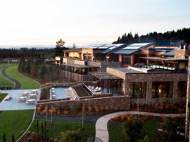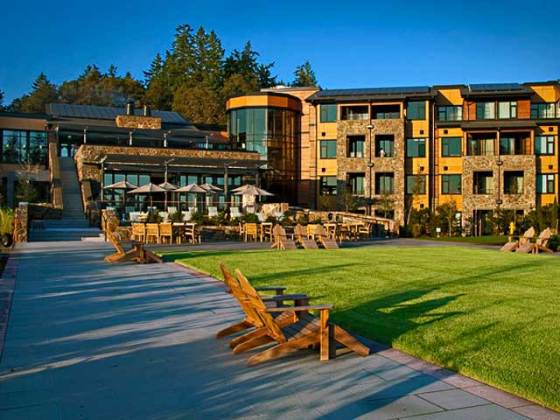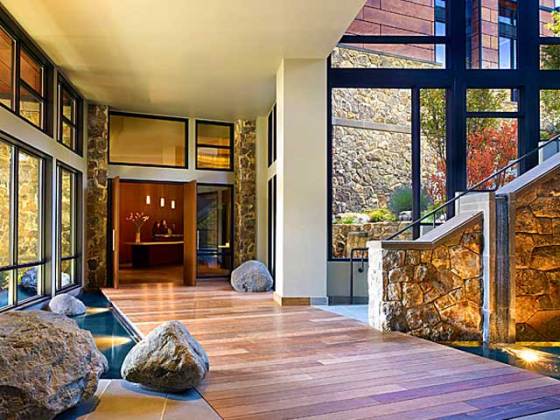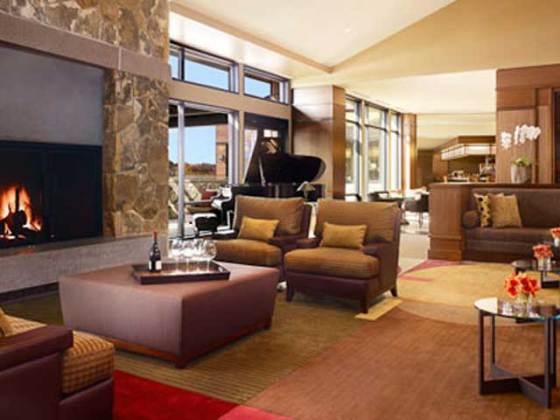Green architecture – The Allison Inn and Spa
 Located 40 kilometers (25 miles) from downtown Portland, the site of The Allison Inn & Spa is a representative of the surrounding Willamette Valley wine country, Oregon. The resort whose architecture, landscape architecture and interior design for The Allison Inn were done by Seattle’s GGLO, received LEED Gold certification from the U.S. Green Building Council.
Located 40 kilometers (25 miles) from downtown Portland, the site of The Allison Inn & Spa is a representative of the surrounding Willamette Valley wine country, Oregon. The resort whose architecture, landscape architecture and interior design for The Allison Inn were done by Seattle’s GGLO, received LEED Gold certification from the U.S. Green Building Council.
The resort features 85 deluxe accommodations, inclusive of 20 suites (all with fireplaces, terrace or balcony, window seat and spa-like bathrooms). The Allison Spa consists of almost 1,400 square meters (15,000 square feet) with twelve treatment rooms, swimming pool, Jacuzzi and Fitness Studio. There is a dedicated entrance with 1,115 square meters (12,000 square feet) of attractive function space inclusive of a Grand Reception Foyer, Ballroom and dedicated Board Room, all with views and outdoor access. Their 100-seat signature restaurant, JORY, showcases Oregon Wine Country cuisine, a five-acre working vineyard and one-acre chef’s garden.
The resort offers many uses which would ordinarily categorize this project as a high energy consuming property. However, incorporation of energy efficiency was a high priority throughout the design process. This focus resulted in an anticipated energy cost savings of almost 50% relative to a conventionally designed building. 55 kW photovoltaic array on southern rooftops produces energy on-site (generating more than a full 7% of the property’s needs) to reduce the need for fossil fuels. Solar Hot Water rooftop collectors reduce the large need for heating water related to the kitchen, laundry, guest rooms, and spa.
Within the 35-acre site more than 70,000 plants and over 1,000 trees have been brought onto the property. Vegetated swales, vegetated open-cell pavement, and settling ponds slow down and remove potential pollutants from storm water run-off. More than 10,000 square feet of lanted roof slows down storm water run-off and rejects solar heat buildup to minimize the building’s microclimate impact. Cleanup of an abandoned underground gasoline storage tank included rehabilitation of the area into a lush estate garden. Extensive native and adaptive vegetation used throughout promotes biodiversity. Low impact vineyard utilizes Integrated Pest Management and is managed by a certified vintner.
Roof forms and materials were designed to take full advantage of the site as well, including the maximization of solar access so that the roof panels can maximize sun capture throughout the day. The wood selected for the exterior is a Prodema (engineered, sealed and polished fine wood product) designed to last as long as possible in Oregon’s variable climate with low maintenance. The use of Montana mossy rock, metal and glass entrances as opposed to timbers is a good example of the emphasis on the practical and timeless.
Drought tolerant vegetation and high efficiency irrigation reduces water use on landscaping. Irrigation equipment is installed to accept the future City of Newberg reclaimed water supply which will eliminate potable water use for landscaping in the near future. Low-flow showerheads, faucets, urinals, and high efficiency toilets reduce water use in public areas and guest rooms. High efficiency kitchen equipment reduces potable water demand.
Energy efficient lighting and controls reduce electricity usage while Variable Refrigerant Volume (VRV) heating and cooling provide superior efficiency in comparison to typical hospitality HVAC systems. Thermally broken, double-pane, low-e windows and south facing orientation reduce heating loads. Computerized guest room ‘check-out’ controls deactivate electricity and set back heating and cooling upon departure to reduce energy consumption in unoccupied rooms.
Products ranging from metal framing to carpet tile contribute a high level of recycled content. Low emitting paints, sealants, carpeting, and cabinetry combined with natural day lighting contribute to the health of the indoor environment. Rapidly renewable aspen fiber flooring enriches the spa, while reducing the demand on old growth timber.













Leave your response!